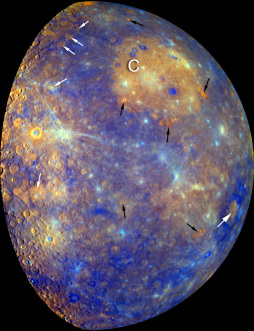Data from the MESSENGER spacecraft’s first flyby of Mercury in January of 2008 are now turning into science results. Several scientists discussed their findings at a press conference today highlighting the MErcury Surface, Space ENvironment, GEochemistry, and Ranging mission, the first spacecraft to visit Mercury since NASA’s Mariner 10 made three flyby passes in 1974 and 1975. Among the findings, scientists discovered volcanism has played a more extensive role in shaping the surface of Mercury than previously thought. MESSENGER data has also identified and mapped surface rock units that
correspond to lava flows, volcanos, and other geological features, showing an apparent planet-wide iron deficiency in Mercury’s surface rocks. Additionally, other instruments made the first observations about the surface and atmospheric composition of the closest world to the sun.
“We have now imaged half of the part of Mercury that was never seen by Mariner 10,” says Mark S. Robinson of Arizona State University, lead author of s study on composition variations in Mercury’s surface rocks using their multispectral colors. “The picture is still incomplete, but we’ll get the other half on October 6th.”
MESSENGER will make two more Mercury flybys (October 6, 2008 and September 29, 2009) before
going into orbit around the planet, March 18, 2011.
MESSENGER’s big-picture finding, says Robinson, is the widespread role played by volcanism. While impact craters are common, and at first glance Mercury still resembles the Moon, much of the planet has been resurfaced through volcanic activity.
“For example, according to our color data the Caloris impact basin is completely filled with smooth plains material that appears volcanic in origin,” Robinson explains. “In shape and form these deposits are very similar to the mare basalt flows on the Moon. But unlike the Moon, Mercury’s smooth plains are low in iron, and thus represent a relatively unusual rock type.”
Mercury’s surface also has a mysterious, widespread low-reflective material Robinson says, “It’s an important and widespread rock that occurs deep in the crust as well as at the surface, yet it has very little ferrous iron in its silicate minerals.”
Another experiment measured the charged particles in the planet Mercury’s magnetic field, which enabled the first observations about the surface and atmospheric composition of Mercury. “We now know more about what Mercury’s made of than ever before,” said Thomas Zurbuchen, a professor at the University of Michigan. “Holy cow, we found way more than we expected!”
Zurbuchen is project leader of the Fast Imaging Plasma Spectrometer (FIPS), a soda can-sized sensor on board the MESSENGER spacecraft.
FIPS detected silicon, sodium, sulfur and even water ions around Mercury. Ions are atoms or molecules that have lost electrons and therefore have an electric charge.
Because of the quantities of these molecules that scientists detected in Mercury’s space environment, they surmise that they were blasted from the surface or exosphere by the solar wind. The solar wind is a stream of charged particles emanating from the sun. It buffets Mercury, which is 2/3 closer to the sun than the Earth, and it causes particles from Mercury’s surface and atmosphere to sputter into space. FIPS measured these sputtered particles.
Mercury and MESSENGER form the subject of 11 papers in a special section devoted to the January flyby in the July 4, 2008, issue of the scientific journal Science.
News Sources: University of Arizona, MESSENGER site

